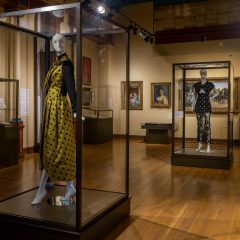(Jennifer visits an exhibit that raises issues of freedom, community, family and the future in China. But there are more universal echoes here as well.–the artblog editors)
What a wonderful time to see contemporary Chinese art in Philadelphia! artblog‘s Rachel Heidenry recently wrote about the current show at Drexel University’s Leonard Pearlstein Gallery which features graduates of the China Central Academy of Art. The Philadelphia Art Alliance is also hosting two acclaimed contemporary Chinese artists in their current exhibition, The Way of the Chopsticks. This site-specific installation by married couple and international art stars Song Dong and Yin Xiuzhen effectively uses the grand domestic spaces of the Art Alliance to explore themes of family and community and how the current trends toward individual luxury in China may lead to a fractured and lonely future.
Yin Xiuzhen has shown her work in Philadelphia previously in the celebrated Half the Sky exhibition, also at the Leonard Pearlstein Gallery. Libby Rosof wrote two pieces on this exhibition: a review featuring Xiuzhen’s work and an interview with Drexel art historian Joseph Gregory, the scholar who since 2008 has been forging relationships with artists and art schools in China. At the Art Alliance, however, it’s Senior Curator Sarah Archer who deserves kudos for bringing Song Dong and Yin Xiuzhen to Philadelphia.
The Household installed in the parlor
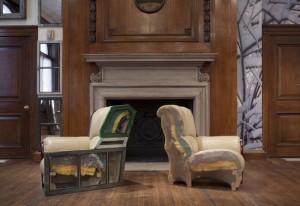
Photo courtesy of Matt Suib/Greenhouse Media.
The Art Alliance’s first floor parlor spaces have been reimagined by the two artists as The Household, an installation of furniture found by Song Dong in Beijing’s many new construction sites. The walls have been papered with an enlarged image of the snow-covered trees which grow outside of Xiuzhen’s studio. Each chair, refrigerator, or end table is cut in half and treated as a “chopstick” sculpture: the artists worked individually on their halves with the hope that, when brought back together, the complete work would function more effectively, like chopsticks.
This furniture would have been typical in Chinese communal households. Now, these items are the discarded remnants of an industry intent on replacing old-world collective living with luxurious, new condos. Song Dong completes his halves of the furniture-sculptures by attaching pieces of salvaged windows; Yin Xiuzhen employs stretched hosiery and concrete dust on her pieces. This hosiery makes her contribution decidedly gendered. Sarah Archer notes that Xiuzhen’s textiles harken in part to first wave Feminist artists in the US who so famously brought such materials into the realm of ‘high art.’ But Xiuzhen’s materials are also political and about women’s lives, international markets, and labor, says Archer, for working in textile factories is often “the default career” for many young Chinese women.
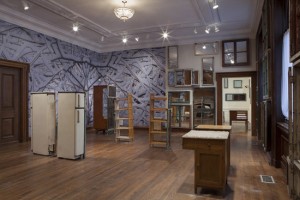
“The Household” is a powerful example of how evocative a successful, site-specific project can be. At first glance, we are in a Rittenhouse Square mansion, but if we look at the walls and into the many reclaimed windows hanging there, which have been outfitted with mirrored glass, we see the snow-covered trees of the wallpaper reflected back and suddenly are transported to China, surrounded by furniture from Beijing.
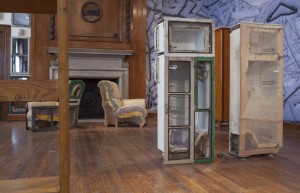
This duality brings up a driving question: what are the similarities or differences between family and domestic life in China and in Philadelphia? In fact, the way that the pieces of furniture in “The Household” are so unequivocally cut in two suggests to me many interesting dichotomies beyond the geographical and cultural: hardness and softness, ruin and repair, function and dysfunction, old and new, fragmentation and completion, community and individuality, male and female.
A tricky decision – the men’s room or the women’s
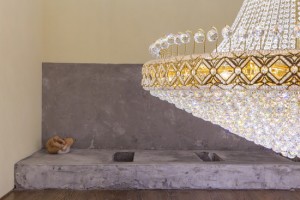
Photo courtesy of Matt Suib/Greenhouse Media.
Visiting the second floor forces a decision about these dichotomies. The landing of the grand staircase is now blocked by a wall with two doors: one to the men’s restroom and one to the women’s. Visitors must decide which one they will use in order to gain entry into the second floor galleries. Bathrooms would have been communally shared spaces in post-revolutionary China, but these restrooms emphasize a new awareness about personal amenities. In the ladies’ room, Yin Xiuzhen has installed a bright, hot, 8-foot tall chandelier, the likes of which one might see in a hotel lobby. This illuminates a row of three rectangular squat toilets found in the bathrooms of old-world China. Near the toilets is a small sculpture of a baby, a reminder of China’s one-child policy and victims of infanticide. It’s a blatant message — no matter how bright the sparkly glow of luxury, it can never illuminate the dark, shadowy corners of human desperation.
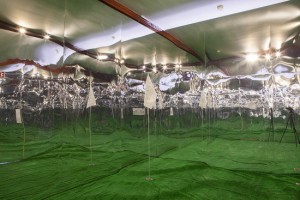
Photo courtesy of Matt Suib/Greenhouse Media.
The men’s room by Song Dong is more humorous and subtle, and perhaps more successful, in its jabs at the absurdity and false facades of blinding, individual indulgence. The room has been made to look like a golf course with Astroturf rugs, sink-drain holes, and mirrored walls which reflect and expand the golf green into infinity. Golf is a growing and desirable leisure-time sport in China, as elsewhere, but this installation makes golf out to be a total sham — the Astroturf carpeting buckles obviously and the wavy, mirrored walls add a funhouse, disorienting effect to our view of this infinite green.
The Chinese family of three and the film Future
Elsewhere in The Way of the Chopsticks, we are continually brought back to ideas of family and domestic life, and the Golden Age domestic spaces of the Art Alliance are the perfect host. The presence of the artists’ ten year old daughter, Song ErRui, is apparent in several instances. Archer told me that Song ErRui is in attendance for most of her parent’s projects and has become a sophisticated world traveler in her own right. She even made a chopstick sculpture for this exhibition. Titled “Third Chopstick,” it is a wonderful, fur covered chopstick made to resemble a wolf, her favorite animal. Song ErRui is also featured in Future, a film on view on the third floor.
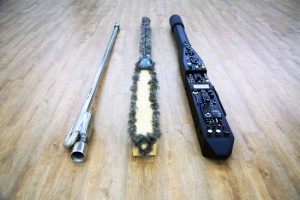
Courtesy of the Philadelphia Art Alliance.
A family of three is the norm in China today but larger, communal family groups were common in the 60s and 70s when Song Dong and Yin Xiuzhen grew up. Their film envisions how this new way of life may affect Song ErRui, who will have a much smaller family to depend upon when she is old. The film, like all of the other works here, is bifurcated, chopstick style, and the two halves are projected side by side.
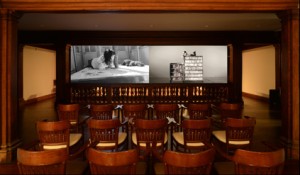
In Yin Xiuzhen’s film, Song ErRui reads, lounges on her mother’s textile sculptures, and eventually morphs into a wolf. In Song Dong’s imagining, his daughter runs through interior spaces filled with bedframes and walls covered in windows, the very same detritus and cast-offs from demolition sites that we encountered in “The Household.” Seeing these items again brings the exhibition full circle and is a reminder of a forever lost past for which Song Dong seems nostalgic. Song ErRui is entirely alone in this film, but like a resourceful ten year old she manages to find many pleasures – she reads, plays with her favorite stuffed wolf, dances and pulls faces in a mirror, and runs and jumps through old furniture. Eventually, her isolation becomes acute, and, morphed into a wolf, she howls at the moon calling for her pack.
“The Way of the Chopsticks” is on view at the Philadelphia Art Alliance through December 29.
All photographs except for “The Future” provided by Canary Promotion.




